Salvador, Brazil
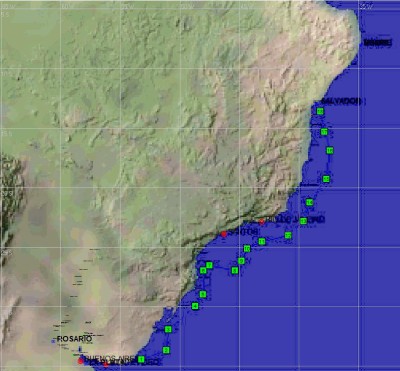 Leaving Punta del Este, Uruguay, the forecasts I had indicated five days of light winds. I needed to get a ways offshore to get away from fishing boat traffic and a part of the coast with few suitable harbors in case of easterly gales. The Brazil current sets strongly southwards along the coast, and a long way offshore. There is a countercurrent going north very close to shore. With the light winds forecast, I doubted I could make much way against the Brazil current offshore, so kept close enough to land to use the countercurrent to get to about where Florianapolis is (point #6). I don’t like being close to a coast, in case a storm comes up, and because there tends to be more traffic to deal with, but keeping relatively close to the coast also gave me an option to enter a port in Brazil and refuel if there was no wind and I motored a lot (in total, I motored about 100 miles, and fuel was not a problem). When I got to near Florianapolis (point #6), the forecast was for light NE winds, going N along the coast to Rio de Janeiro. I figured the normal current and countercurrent were likely to be less than normal due to the winds having been not from the typical direction over the last few days (a gale in Rio de la Plata had affected the winds at this latitude). If I stayed along the coast, using the countercurrent, I figured that the countercurrent would not be very strong, and the wind would be totally against me. Also, there is a military exercise area along that coast, and an offshore oil field off the corner (off Cabo Frio, near point #13). Between Cabo Frio and the offshore oil field is a relatively shallow area full of fishing boats. Staying farther offshore would allow me to avoid a lot of traffic, and didn’t seem like it would be significantly slower at this point to go against the Brazil current instead of with the countercurrent. I was alone for this trip, so the concerns about traffic I had would probably not be as great if I was not singlehanding.Around point #11, the wind became more and more favorable, and around point #14, I was starting to get into the SE Trade Winds, which are really favorable for going north.
Leaving Punta del Este, Uruguay, the forecasts I had indicated five days of light winds. I needed to get a ways offshore to get away from fishing boat traffic and a part of the coast with few suitable harbors in case of easterly gales. The Brazil current sets strongly southwards along the coast, and a long way offshore. There is a countercurrent going north very close to shore. With the light winds forecast, I doubted I could make much way against the Brazil current offshore, so kept close enough to land to use the countercurrent to get to about where Florianapolis is (point #6). I don’t like being close to a coast, in case a storm comes up, and because there tends to be more traffic to deal with, but keeping relatively close to the coast also gave me an option to enter a port in Brazil and refuel if there was no wind and I motored a lot (in total, I motored about 100 miles, and fuel was not a problem). When I got to near Florianapolis (point #6), the forecast was for light NE winds, going N along the coast to Rio de Janeiro. I figured the normal current and countercurrent were likely to be less than normal due to the winds having been not from the typical direction over the last few days (a gale in Rio de la Plata had affected the winds at this latitude). If I stayed along the coast, using the countercurrent, I figured that the countercurrent would not be very strong, and the wind would be totally against me. Also, there is a military exercise area along that coast, and an offshore oil field off the corner (off Cabo Frio, near point #13). Between Cabo Frio and the offshore oil field is a relatively shallow area full of fishing boats. Staying farther offshore would allow me to avoid a lot of traffic, and didn’t seem like it would be significantly slower at this point to go against the Brazil current instead of with the countercurrent. I was alone for this trip, so the concerns about traffic I had would probably not be as great if I was not singlehanding.Around point #11, the wind became more and more favorable, and around point #14, I was starting to get into the SE Trade Winds, which are really favorable for going north.
Monthly Archives: April 2009
Sailing towards the sunrise
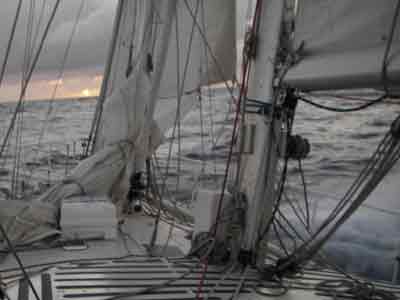 The fisherman is the sail that is tied down on deck in the picture, the voile d’etai (main staysail) is fully rolled up. The boat is sailing nicely to windward with mainsail, genoa and trinquette (fore staysail), towards the rising sun.
The fisherman is the sail that is tied down on deck in the picture, the voile d’etai (main staysail) is fully rolled up. The boat is sailing nicely to windward with mainsail, genoa and trinquette (fore staysail), towards the rising sun.
Moonrise
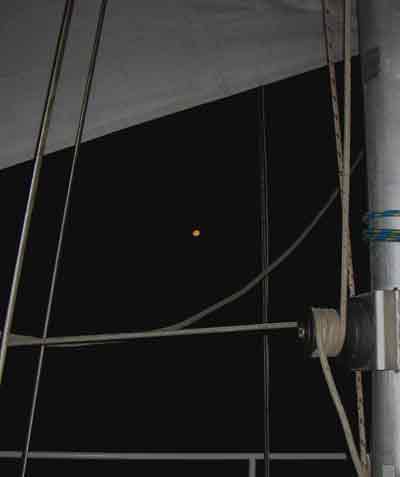 The moon has been pretty full for the last week, giving lots of light for most of the night. Here the moon is rising underneath the voile d’etai (main staysail). Weather went from hot and humid yesterday to light and squally last night and today. A midnight squall provided the opportunity for a refreshing freshwater shower while getting the fisherman down.
The moon has been pretty full for the last week, giving lots of light for most of the night. Here the moon is rising underneath the voile d’etai (main staysail). Weather went from hot and humid yesterday to light and squally last night and today. A midnight squall provided the opportunity for a refreshing freshwater shower while getting the fisherman down.
Ship in the distance
 On the right, just above the rail, is the ship Mol Bravery, crossing six miles ahead. Have seen many ships this trip, they are easy to deal with mostly due to AIS. Fortunately, have not seen many fishing boats so far. Have been avoiding the banks where they are likely to be working as much as possible. Fishing boats usually don’t have AIS transmitters, the smaller ones don’t show up well on yacht radars, and there are all sorts of warnings about small unlit fishing boats near this coast.
On the right, just above the rail, is the ship Mol Bravery, crossing six miles ahead. Have seen many ships this trip, they are easy to deal with mostly due to AIS. Fortunately, have not seen many fishing boats so far. Have been avoiding the banks where they are likely to be working as much as possible. Fishing boats usually don’t have AIS transmitters, the smaller ones don’t show up well on yacht radars, and there are all sorts of warnings about small unlit fishing boats near this coast.
Sunset at the foremast
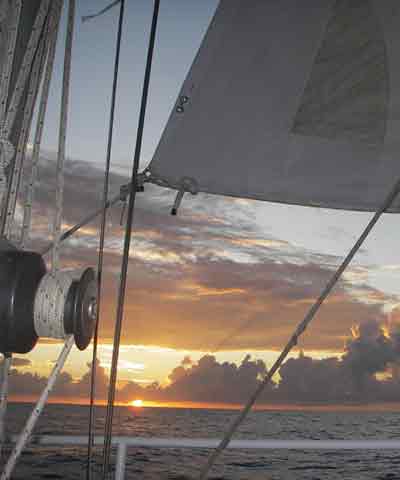 The genoa is the sail in the picture. I mentioned a vessel or oil rig called Andromeda yesterday. When I got closer and the mist cleared a bit, I could see it was a very large tanker, just sitting offshore in 3000 metres of water. I guess it is waiting to get to the loading dock at one of the oil wells.
The genoa is the sail in the picture. I mentioned a vessel or oil rig called Andromeda yesterday. When I got closer and the mist cleared a bit, I could see it was a very large tanker, just sitting offshore in 3000 metres of water. I guess it is waiting to get to the loading dock at one of the oil wells.
View from the foredeck
 The sail on the right in the picture is the trinquette or fore-staysail, the sail in the middle of the picture (the highest one) is the fisherman, and the left-most sail (low) is the voile d’etai or main staysail. After a few hours of no wind yesterday, a light, favorable wind came up and has stayed since, making for pleasant sailing in small seas. The oilfield area mentioned yesterday has been passed, and we are in deep (3000 metre) water, so there should not be many fishing boats around. Something very large and well-lit appears to be stationary about 12 miles east. Too far to be able to see what it is with binoculars, the AIS only reports the name of it (not position, course and speed like it usually does), Andromeda. Doesn’t sound like a ship name. I didn’t think oil rigs drilled this deeply, but maybe they do?
The sail on the right in the picture is the trinquette or fore-staysail, the sail in the middle of the picture (the highest one) is the fisherman, and the left-most sail (low) is the voile d’etai or main staysail. After a few hours of no wind yesterday, a light, favorable wind came up and has stayed since, making for pleasant sailing in small seas. The oilfield area mentioned yesterday has been passed, and we are in deep (3000 metre) water, so there should not be many fishing boats around. Something very large and well-lit appears to be stationary about 12 miles east. Too far to be able to see what it is with binoculars, the AIS only reports the name of it (not position, course and speed like it usually does), Andromeda. Doesn’t sound like a ship name. I didn’t think oil rigs drilled this deeply, but maybe they do?
Sunset
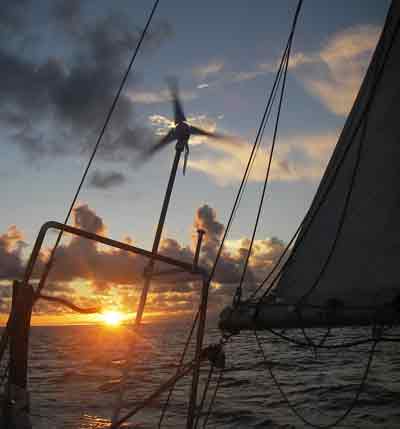 Had great wind yesterday (picture is from a couple of days ago, in light wind), force 3-6 from behind. Sailing farther offshore now to go around a Brazilian oilfield where access is restricted.
Had great wind yesterday (picture is from a couple of days ago, in light wind), force 3-6 from behind. Sailing farther offshore now to go around a Brazilian oilfield where access is restricted.
Squall
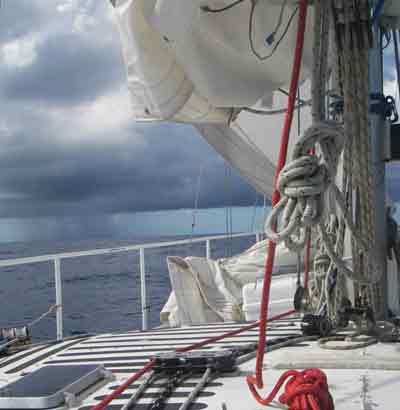 The rain (the dark area underneath part of the cloud in the picture) ahead has a squall (sudden increase in wind speed and often direction) with it. When this is coming for you, you get down some sails to be prepared for the much higher wind that you expect the squall to have. After a few minutes, it is generally over, and you tend to have the same wind speed and direction as you did before the squall. There is an old sailor’s rhyme about dealing with squalls: When rain comes before the wind, topsail sheets and halyards mind When wind comes before the rain, hoist your topsails up again Yesterday the wind varied from Force 0 to Force 7, as it was mostly a squally day requiring lots of sail changes. The wind direction was favorable, though, so that was nice.
The rain (the dark area underneath part of the cloud in the picture) ahead has a squall (sudden increase in wind speed and often direction) with it. When this is coming for you, you get down some sails to be prepared for the much higher wind that you expect the squall to have. After a few minutes, it is generally over, and you tend to have the same wind speed and direction as you did before the squall. There is an old sailor’s rhyme about dealing with squalls: When rain comes before the wind, topsail sheets and halyards mind When wind comes before the rain, hoist your topsails up again Yesterday the wind varied from Force 0 to Force 7, as it was mostly a squally day requiring lots of sail changes. The wind direction was favorable, though, so that was nice.
Sunset
 Have had a lot of light winds, mostly from ahead, so far this trip. While that has resulted in really slow progress, it also makes for a lot of pretty sunsets.
Have had a lot of light winds, mostly from ahead, so far this trip. While that has resulted in really slow progress, it also makes for a lot of pretty sunsets.
The Fisherman
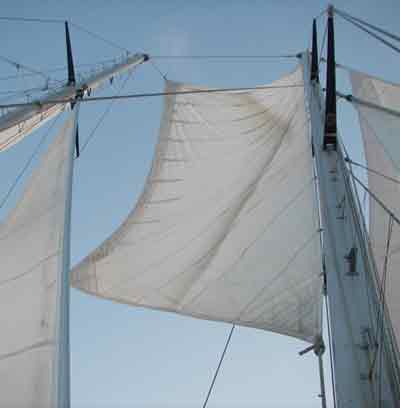 The fisherman sail is a four-cornered sail that sets high up, between the masts of a schooner. The name fisherman comes from the use of schooners for fishing off the east coast of North America, where fisherman would hang their nets to dry between the masts. Later, sails put up in their place were called fisherman sails. The fisherman sail is one of the nice things about the schooner rig, as it is not quite as difficult a sail to handle as a spinnaker (the multicolored balloon-like sails generally set poled out), and gets sail area up high, where there is more wind. Originally, the fisherman on this boat was set from a roller-furling rig on the aft side of the foremast. That never worked well, as the roller-furling rig didn’t entirely fit the sail, and setting the sail involved climbing 12m up the mast to pull the sail out of the furler. Instead of using the roller-furling rig, I had slides put on the luff (leading edge of the sail), so the fisherman is slid up and down the foremast for raising and lowering the sail. Keeping the luff attached to the foremast makes it much easier to raise and lower the fisherman by oneself. Because I was not using the original furling mechanism, I started setting the fisherman upside-down from how it had been set before (it fit the space now available better that way). This resulted in different parts of the sail chafing against the wires of the rigging. So I had more chafe patches put on the sail to prevent the chafe from damaging it. In Argentina, I asked a sailmaker to change the shape of the top, so that it fit the space even better. I wanted a panel added to the top, so the whole sail would be bigger, as well as one top corner cut down so it would be possible to raise it to the top of both masts. The sailmaker pointed out it would be easy to cut down one corner, but difficult to add to the sail. So the corner was cut down and the sail made slightly smaller. I’m experimenting with how high I want the sail now (highest for getting the sail where there is the most wind, but the higher it is the harder it is to raise it without anything getting caught), which is why it isn’t quite at the top of the masts in this picture. Raising it up is also going to change where the sail chafes against the rigging wires, so will involve some new chafe patches. The dark line in the sail is where the sail has rubbed against the rigging wires. After sailing with this for a while, I’ll have a new line in the sail to look at to see where to put the chafe patches.
The fisherman sail is a four-cornered sail that sets high up, between the masts of a schooner. The name fisherman comes from the use of schooners for fishing off the east coast of North America, where fisherman would hang their nets to dry between the masts. Later, sails put up in their place were called fisherman sails. The fisherman sail is one of the nice things about the schooner rig, as it is not quite as difficult a sail to handle as a spinnaker (the multicolored balloon-like sails generally set poled out), and gets sail area up high, where there is more wind. Originally, the fisherman on this boat was set from a roller-furling rig on the aft side of the foremast. That never worked well, as the roller-furling rig didn’t entirely fit the sail, and setting the sail involved climbing 12m up the mast to pull the sail out of the furler. Instead of using the roller-furling rig, I had slides put on the luff (leading edge of the sail), so the fisherman is slid up and down the foremast for raising and lowering the sail. Keeping the luff attached to the foremast makes it much easier to raise and lower the fisherman by oneself. Because I was not using the original furling mechanism, I started setting the fisherman upside-down from how it had been set before (it fit the space now available better that way). This resulted in different parts of the sail chafing against the wires of the rigging. So I had more chafe patches put on the sail to prevent the chafe from damaging it. In Argentina, I asked a sailmaker to change the shape of the top, so that it fit the space even better. I wanted a panel added to the top, so the whole sail would be bigger, as well as one top corner cut down so it would be possible to raise it to the top of both masts. The sailmaker pointed out it would be easy to cut down one corner, but difficult to add to the sail. So the corner was cut down and the sail made slightly smaller. I’m experimenting with how high I want the sail now (highest for getting the sail where there is the most wind, but the higher it is the harder it is to raise it without anything getting caught), which is why it isn’t quite at the top of the masts in this picture. Raising it up is also going to change where the sail chafes against the rigging wires, so will involve some new chafe patches. The dark line in the sail is where the sail has rubbed against the rigging wires. After sailing with this for a while, I’ll have a new line in the sail to look at to see where to put the chafe patches.